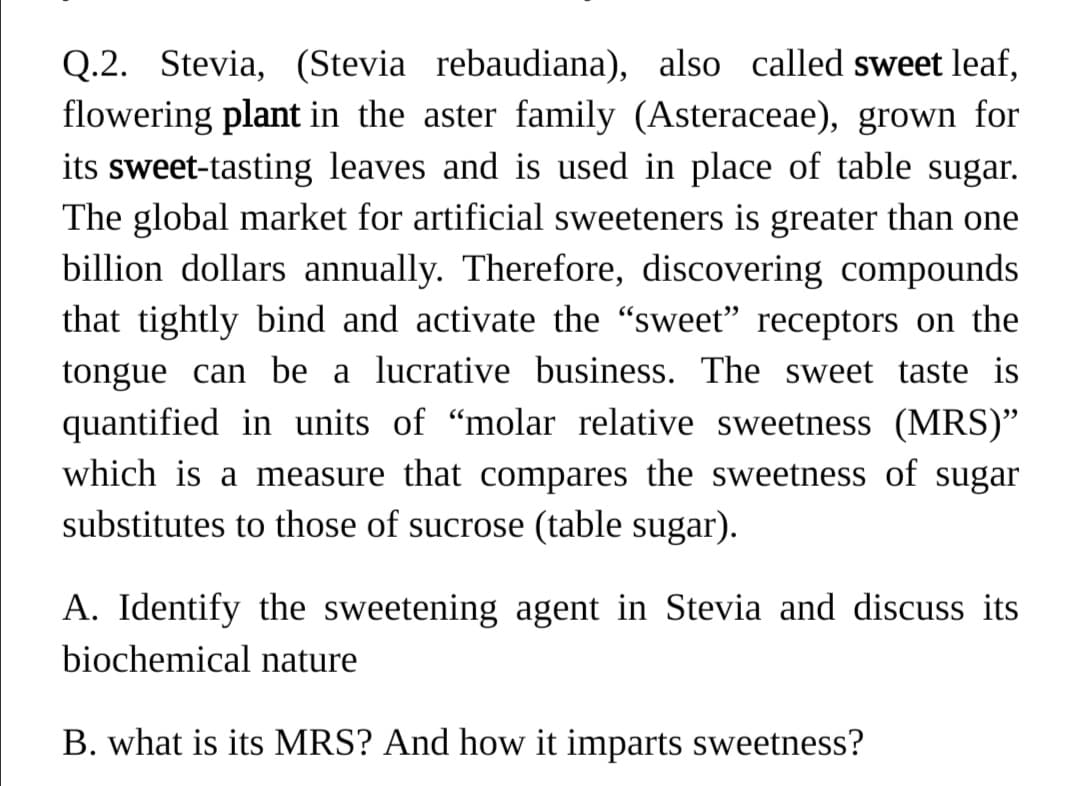Q.2. Stevia, (Stevia rebaudiana), also called sweet leaf, flowering plant in the aster family (Asteraceae), grown for its sweet-tasting leaves and is used in place of table sugar. The global market for artificial sweeteners is greater than one billion dollars annually. Therefore, discovering compounds
Q.2. Stevia, (Stevia rebaudiana), also called sweet leaf, flowering plant in the aster family (Asteraceae), grown for its sweet-tasting leaves and is used in place of table sugar. The global market for artificial sweeteners is greater than one billion dollars annually. Therefore, discovering compounds
Biology: The Unity and Diversity of Life (MindTap Course List)
14th Edition
ISBN:9781305073951
Author:Cecie Starr, Ralph Taggart, Christine Evers, Lisa Starr
Publisher:Cecie Starr, Ralph Taggart, Christine Evers, Lisa Starr
Chapter33: Sensory Perception
Section: Chapter Questions
Problem 1CT: Like other nocturnal carnivores, the ferret shown in FIGURE 33.13 has light-reflecting material in...
Related questions
Question
100%

Transcribed Image Text:Q.2. Stevia, (Stevia rebaudiana), also called sweet leaf,
flowering plant in the aster family (Asteraceae), grown for
its sweet-tasting leaves and is used in place of table sugar.
The global market for artificial sweeteners is greater than one
billion dollars annually. Therefore, discovering compounds
that tightly bind and activate the "sweet" receptors on the
tongue can be a lucrative business. The sweet taste is
quantified in units of "molar relative sweetness (MRS)"
which is a measure that compares the sweetness of sugar
substitutes to those of sucrose (table sugar).
A. Identify the sweetening agent in Stevia and discuss its
biochemical nature
B. what is its MRS? And how it imparts sweetness?
Expert Solution
This question has been solved!
Explore an expertly crafted, step-by-step solution for a thorough understanding of key concepts.
Step by step
Solved in 3 steps

Knowledge Booster
Learn more about
Need a deep-dive on the concept behind this application? Look no further. Learn more about this topic, biochemistry and related others by exploring similar questions and additional content below.Recommended textbooks for you

Biology: The Unity and Diversity of Life (MindTap…
Biology
ISBN:
9781305073951
Author:
Cecie Starr, Ralph Taggart, Christine Evers, Lisa Starr
Publisher:
Cengage Learning

Biology: The Dynamic Science (MindTap Course List)
Biology
ISBN:
9781305389892
Author:
Peter J. Russell, Paul E. Hertz, Beverly McMillan
Publisher:
Cengage Learning

Biology: The Unity and Diversity of Life (MindTap…
Biology
ISBN:
9781337408332
Author:
Cecie Starr, Ralph Taggart, Christine Evers, Lisa Starr
Publisher:
Cengage Learning

Biology: The Unity and Diversity of Life (MindTap…
Biology
ISBN:
9781305073951
Author:
Cecie Starr, Ralph Taggart, Christine Evers, Lisa Starr
Publisher:
Cengage Learning

Biology: The Dynamic Science (MindTap Course List)
Biology
ISBN:
9781305389892
Author:
Peter J. Russell, Paul E. Hertz, Beverly McMillan
Publisher:
Cengage Learning

Biology: The Unity and Diversity of Life (MindTap…
Biology
ISBN:
9781337408332
Author:
Cecie Starr, Ralph Taggart, Christine Evers, Lisa Starr
Publisher:
Cengage Learning

Anatomy & Physiology
Biology
ISBN:
9781938168130
Author:
Kelly A. Young, James A. Wise, Peter DeSaix, Dean H. Kruse, Brandon Poe, Eddie Johnson, Jody E. Johnson, Oksana Korol, J. Gordon Betts, Mark Womble
Publisher:
OpenStax College

Human Physiology: From Cells to Systems (MindTap …
Biology
ISBN:
9781285866932
Author:
Lauralee Sherwood
Publisher:
Cengage Learning